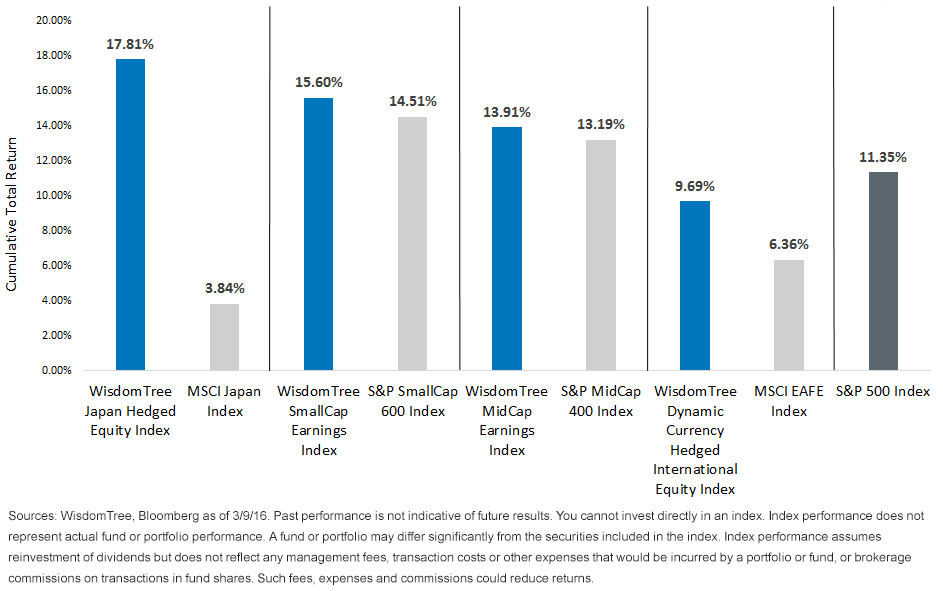The Fed Moves: What It May Mean for Equities



After the election of Donald Trump as president on November 8, markets saw the 10-Year Treasury yield rise an impressive 75 basis points (bps) to its peak of 2.6% on December 15. The 10-Year recently touched that peak again on March 9. From the presidential election through March 9, the U.S. dollar rallied 4.3%, according to the Bloomberg Dollar Spot Index. Given the recent rate hike, and that many market participants believe there are additional rate hikes on the horizon, what are the equity asset classes that may benefit from rising rates and a rising dollar? We begin that discussion with what has performed well following President Trump’s victory through the recent peak of the 10-Year Treasury yield on March 9.1
Equity Asset Class Returns since the Presidential Election, 11/8/16–3/9/17

For definitions of indexes in the chart, visit our glossary.
U.S. Mid- and Small Caps
Since the presidential election, markets have seen significant rallies in indexes more exposed to mid- and small-cap companies. In general, smaller-capitalization companies tend to outperform during rising rate environments. This is the case for a variety of reasons, including greater sensitivity to expectations for U.S. gross domestic product (GDP) growth, weaker headwinds from a rising dollar compared to global large caps and, specific to this rising rate period, the expectation of corporate tax cuts. Although the promise of regulatory relief for the financial and health care sectors—and the impact that potential repatriation of foreign profits could have on multinational technology stocks—have led large caps to outperform mid- and small-cap stocks thus far in 2017, mid- and small-cap stocks may rally in the second half of the year if tax cuts or tax reform passes later in the summer. As we can see from the chart above, mid- and small caps have outperformed the S&P 500 Index, which returned 11%, since the election in November. But in the mid- and small-cap asset classes, using profitable companies and then weighting them based on their earnings has generated excess returns compared to traditional beta benchmarks that weight companies by market capitalization.
Hedged Japanese Equities
During this postelection rising rate and rising dollar period, Japanese equities performed quite well depending on how they were positioned. With an almost 14% difference between the currency-hedged WisdomTree Index and the unhedged MSCI Japan Index, one can observe just how potent currency movements can be when considering returns. But the WisdomTree Japan Hedged Equity Index takes it one step further, including only dividend-paying companies, weighting by their share of the Dividend Stream® and tilting exposure toward exporters who stand to benefit from a depreciating yen relative to the dollar. One reason WisdomTree believes so strongly in tilting toward exporters and neutralizing currency exposure is because of the historical tendency for Japanese equities to be negatively correlated to the yen. If interest rates head higher in the U.S., we believe this may result in further depreciation of the yen, which could prove to be an additional catalyst for Japanese stocks.
Managing Currency Risk Internationally
Much like we saw in Japan, a rising dollar can erode returns when investing overseas. One way to reduce this risk is with a strategy that dynamically hedges foreign currencies monthly to mitigate the impact of currency risk in a rising dollar environment. We see above how the WisdomTree Dynamic Currency Hedged International Equity Index outperformed the MSCI EAFE Index over this period. The Index uses three signals—momentum, interest rate differentials and relative valuations—to determine how much of each foreign currency exposure should be neutralized at the end of each month. This led to the Index having an aggregate currency-hedge ratio between 67% and 75% from November to March. Currently, the WisdomTree Index is 68% hedged for the month of March. We believe dynamic currency hedging is a potentially valuable tool, not just for rising rate periods, but also to intelligently manage currency risk in the core of your portfolio over full market cycles.
Conclusion
Looking at the most recent rising rate period, it is clear that these asset classes, when positioned appropriately, outperformed. Yet, as many of us know, past performance is not indicative of future results. But if you believe that recent movements in the 10-Year Treasury and the U.S. dollar might continue, and that the most recent rising rate period could be indicative of the one that may occur, these asset classes may be worth keeping an eye on. WisdomTree offers exchange-traded funds (ETFs) in these assets classes through the WisdomTree MidCap Earnings Fund (EZM), the WisdomTree SmallCap Earnings Fund (EES), the WisdomTree Japan Hedged Equity Fund (DXJ) and the WisdomTree Dynamic Currency Hedged International Equity Fund (DDWM).
Unless otherwise noted all data is from Bloomberg as of 3/9/2017
1This recent 10-Year peak is as of the writing of this blog on March 9
Important Risks Related to this Article
Performance, especially for very short time periods, should not be the sole factor in making your investment decision.
There are risks associated with investing, including possible loss of principal. Funds focusing their investments on certain sectors, regions and/or smaller companies increase their vulnerability to any single economic or regulatory development. This may result in greater share price volatility.
Foreign investing involves special risks, such as risk of loss from currency fluctuation or political or economic uncertainty. . Investments in currency involve additional special risks, such as credit risk, interest rate fluctuations, derivative investments which can be volatile and may be less liquid than other securities, and more sensitive to the effect of varied economic conditions. As certain Funds can have a high concentration in some issuers, they can be adversely impacted by changes affecting those issuers. Due to the investment strategy of certain Funds they may make higher capital gain distributions than other ETFs.
DDWM invests in derivatives in seeking to obtain a dynamic currency hedge exposure. Derivative investments can be volatile, and these investments may be less liquid than other securities, and more sensitive to the effects of varied economic conditions. Derivatives used by the Fund may not perform as intended.. The composition of the Index underlying the Fund is heavily dependent on quantitative models and data from one or more third parties, and the Index may not perform as intended. The Fund invests in the securities included in, or representative of, its Index regardless of their investment merit, and the Fund does not attempt to outperform its Index or take defensive positions in declining markets. Please read each Fund’s prospectus for specific details regarding each Fund’s risk profile.



